Nokia 4A0-101 Alcatel-Lucent Interior Routing Protocols and High Availability Exam Practice Test
Alcatel-Lucent Interior Routing Protocols and High Availability Questions and Answers
A default route for a client is also known as the:
An OSPF ASBR must have at least one interface in the backbone area (area 0)
What must be configured on the Alcatel-Lucent 7750 SR for RIP to advertise locally attached links?
In an OSPF environment, what must a router receive after it sends out an update?
What best describes the type of packets used by OSPF routers to exchange updates on a pointto-point link?
A static route is created using the command "static-route 0.0.0.0/0 next-hop 3.3.3.1". What command could be used to test the static route on an Alcatel-Lucent 7750 SR?
An OSPF router receives an update in which the sequence number, age, and checksum are the same as the entry already in the topological database. What action is taken by the router?
How many databases does a Link State routing protocol use?
Click the exhibit button.
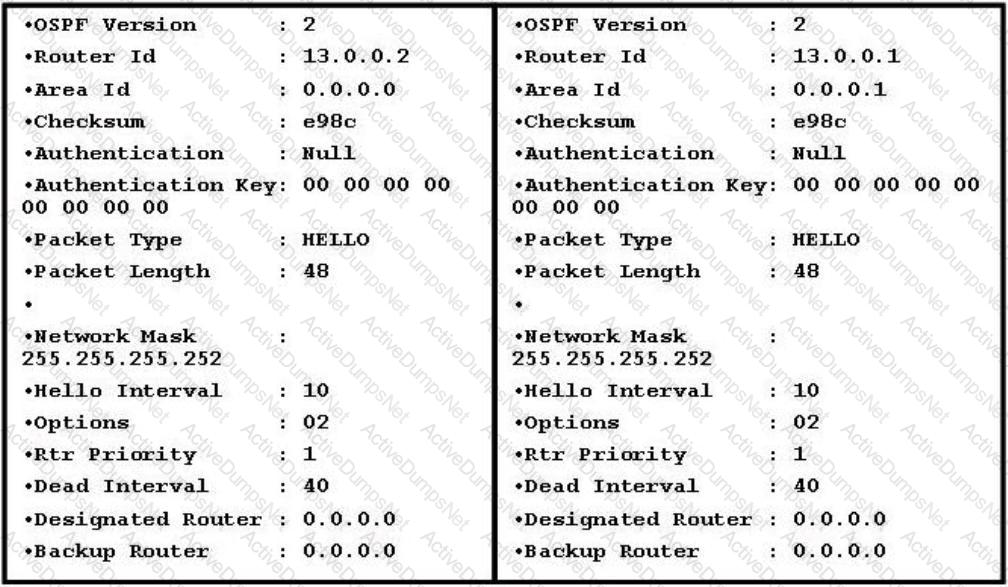
Two neighboring OSPF routers have exchanged the packets shown. What state is the adjacency in?
Which of the following is NOT a characteristic of RIPv1?:
Click on the exhibit.
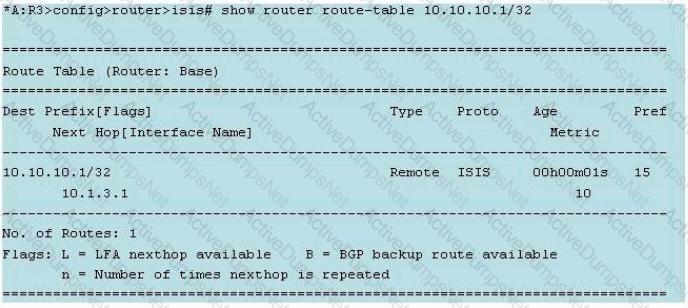
The operator of an IS-IS network wishes to have link metrics dynamically calculated in the same manner as OSPF. The router with system address 10.10.10.1 is one hop away on a 1 Gbps link
Which of the following is correct?
Click on the exhibit.
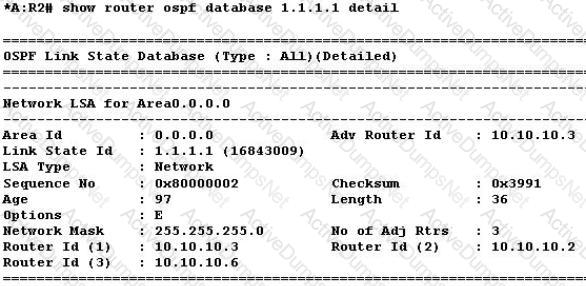
Which router is the designated router for the broadcast network?
Click on the exhibit.
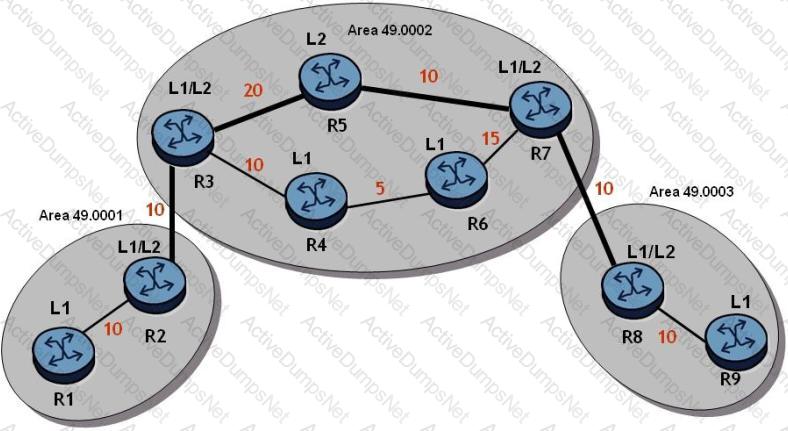
The numbers beside the links are the metrics for that link.
Given the diagram, what path will traffic follow from router R2 to router R8, and from router R8 to router R2, if IS-IS is the routing protocol?
Which of the following is not included in a Router LSA?
Which LSA type is not found in point-to-point only OSPF networks?
Click on the exhibit.
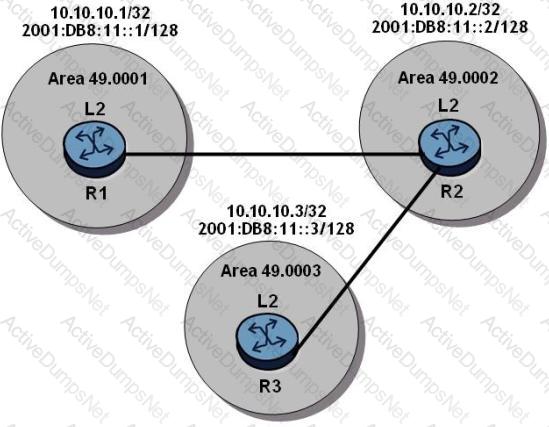
The routers have an established IS-IS L2 adjacency on which IPv4 system addresses are exchanged. An operator successfully configures multi-topology IS-IS routing so that the IPv6 system addresses are also exchanged between routers.
After IPv6 has been configured, which of the following is TRUE?
Click on the exhibit.
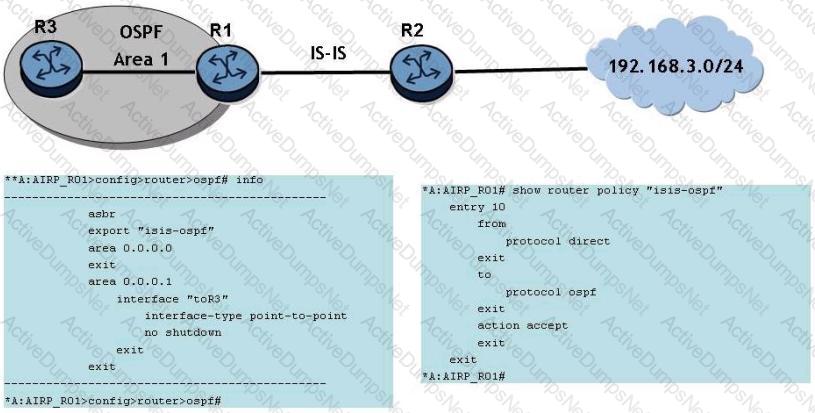
Router R1 learns the network 192.168.3.0/24 from IS-IS. Given the OSPF configuration shown, why isn't the 192.168.3.0/24 route in router R3's route table?
Click on the exhibit.

Router R4 is being added to the network and it is connected to a non-OSPF domain.
Which area type should be used for Area 1 to allow the external routes to be advertised into Area 0?
Which of the following concerning OSPFv3 is TRUE?
What type of LSA is used to flood information about prefixes from one OSPF area to other attached areas?
When IS-IS elects a DIS, what is used as the tie breaker on an Alcatel-Lucent 7750 SR, if the priorities are the same?
Which of the following OSPF area types are supported by the Alcatel- Lucent 7750 SR? Choose two answers.
Which of the following statements regarding IS-IS LSPs is true?
Which of the following statements regarding area border routers in an OSPF network is true?
Click the exhibit button.
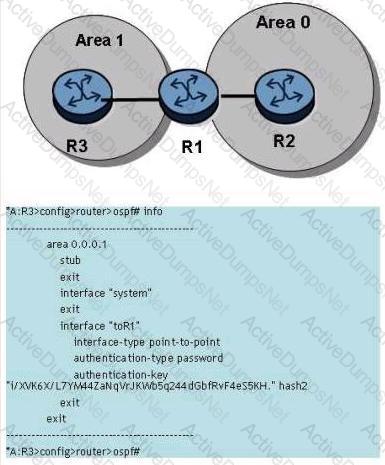
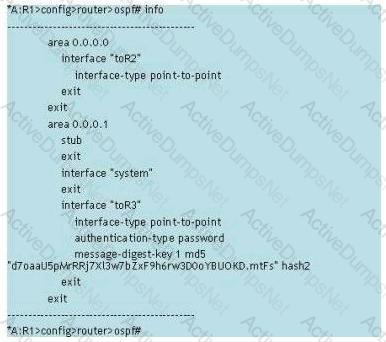
The OSPF adjacency between routers R3 and R1 is down. What is the problem?
Which of the following cannot be used as a matching criterion in route policy statements?
Click the exhibit button.
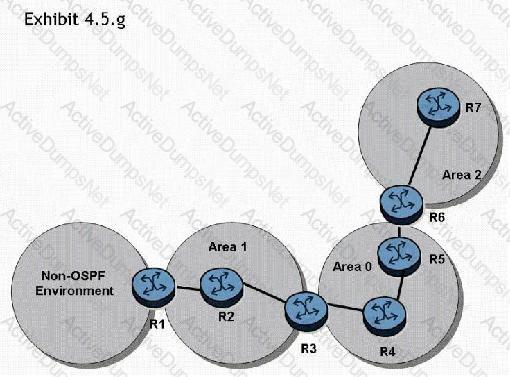
In the topology shown, router R1 is an ASBR configured to export external routes to OSPF. Assuming that there are no stub networks, which of the following statements regarding type 4 LSA generation is true?
What causes an adjacency to change from down to two ways?
Click the exhibit button.
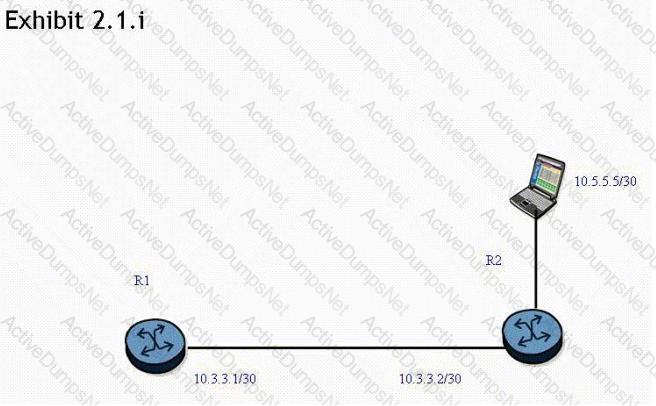
A static route is created on router R1 "using the "static-route 0.0.0.0/0 next-hop 10.3.3.2" command. What command can be used to test the static route on an Alcatel-Lucent 7750 SR?
What is the default preference value for a static route in the Alcatel-Lucent 7750 SR?
In OSPFv3, which of the following LSA types carries prefixes and is only flooded in the area where it is generated?
Click on the exhibit.
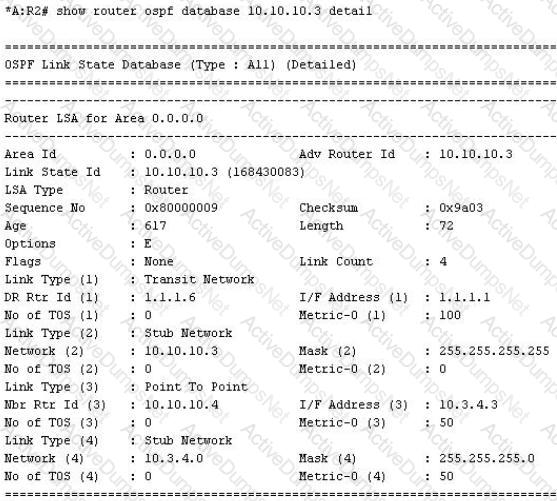
Given the contents of the Router LSA, which of the following best describes the local topology of the router?
Which of the following is a characteristic of OSPFv2 that was NOT preserved in OSPFv3?
Click on the exhibit.

What type of OSPFv3 LSA is shown?
Click on the exhibit.
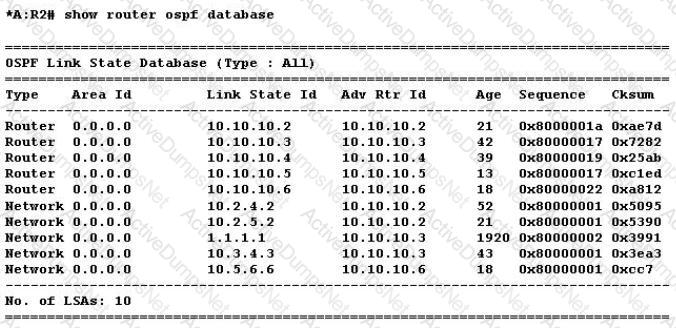
Given the output, which of the following is the most accurate statement about the network?
An OSPF backbone area contains Type 5 LSAs. If an attached area receives only Summary LSAs from the backbone area, what type of area is the attached area?
Click on the exhibit.
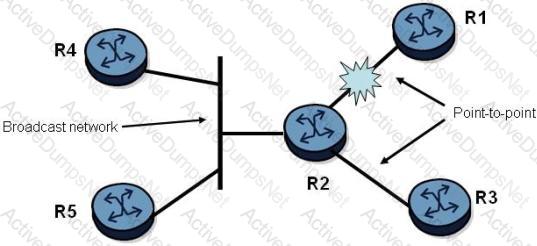
OSPF router R2 has both point-to-point and broadcast interfaces and it is not a DR for any interfaces. Router R2 detects the link failure between itself and router R1.
Which of the following is correct?
Which of the following best describes the forwarding of a IPv6 packet that has a destination anycast address?
Which OSPFv3 LSA advertises the location of an ASBR?
Click on the exhibit.
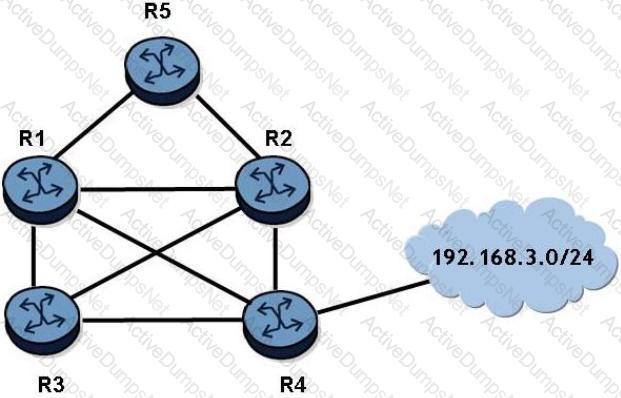
OSPF is operational on all links in the network diagram, all links are the same cost, and all routers are configured with an ECMP value of 4. Router R4 advertises the prefix 192.168.3.0/24 into OSPF.
How many entries for prefix 192.168.3.0/24 will be in router R5's routing table?
Click the exhibit button.
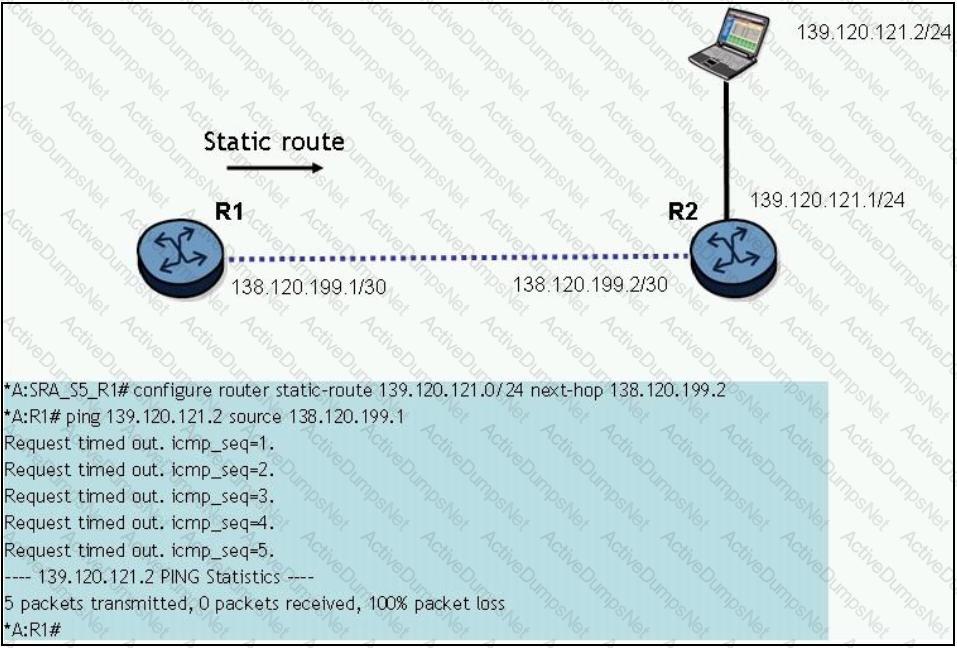
A static route has been configured on router R1 to reach the PC at 139.120.121.2. However, as shown in the exhibit, the ping fails. What is the most likely cause of the problem?
Which of the following statements regarding OSPF routing updates on a point-to-point link is true?
Click the exhibit button.

Router 2 advertises the network 192.168.3.0/24 to router R1 via IS-IS.
How can router R1 ensure that it discards the route?
Which of the following statements are true? Choose two answers.
Refer to the exhibit below. The routers have an established IS-IS L2 adjacency on which IPv4 system addresses are exchanged. An operator successfully configures multi-topology IS-IS routing so that the IPv6 system addresses are also exchanged between routers. Which of the following statements best describes the number of IS-IS adjacencies and the number of LSPs in the LSDB of R1 AFTER IPv6 has been configured?
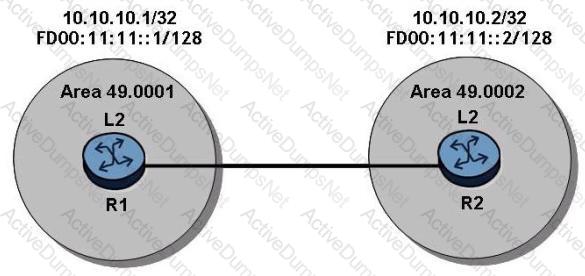
How are LSPs acknowledged on IS-IS broadcast links?
Click the exhibit button.
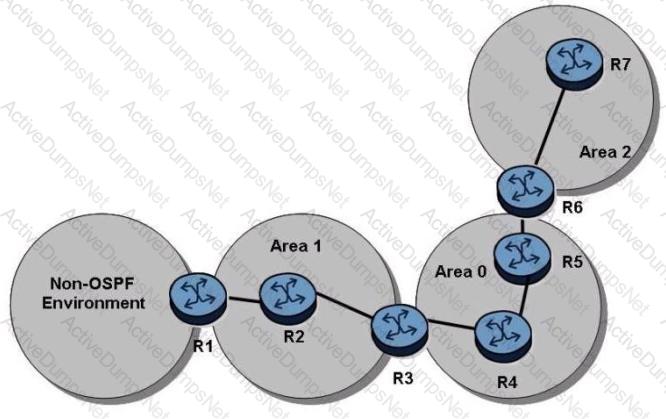
In the topology shown, router R1 is an ASBR configured to export external routes to OSPF. Assuming that there are no stub networks, which of the following statements regarding Type 4 LSA generation is true?
